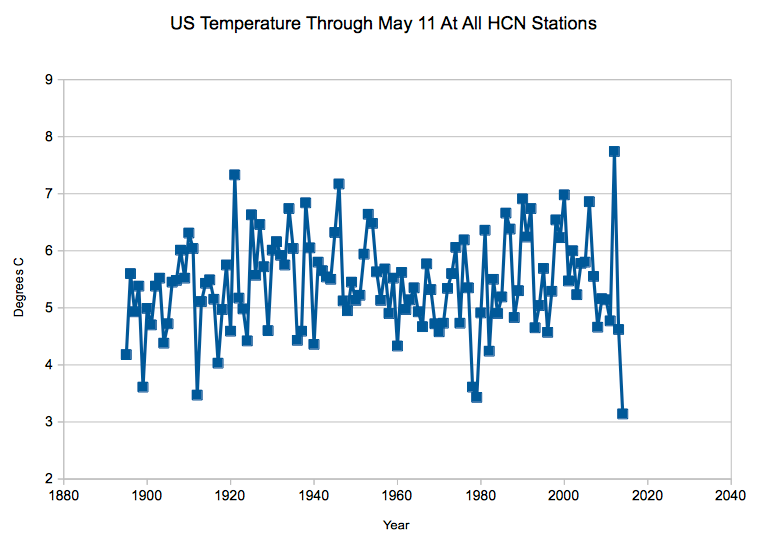Through May 11, this year is the coldest year on record in the US. The gap between 2014 and the next coldest is likely to widen over the next week.
Disrupting the Borg is expensive and time consuming!
Google Search
-
Recent Posts
- Fact Checking NASA
- Fact Checking Grok
- Fact Checking The New York Times
- New Visitech Features
- Ice-Free Arctic By 2014
- Debt-Free US Treasury Forecast
- Analyzing Big City Crime (Part 2)
- Analyzing Big City Crime
- UK Migration Caused By Global Warming
- Climate Attribution In Greece
- “Brown: ’50 days to save world'”
- The Catastrophic Influence of Bovine Methane Emissions on Extraterrestrial Climate Patterns
- Posting On X
- Seventeen Years Of Fun
- The Importance Of Good Tools
- Temperature Shifts At Blue Hill, MA
- CO2²
- Time Of Observation Bias
- Climate Scamming For Profit
- Climate Scamming For Profit
- Back To The Future
- “records going back to 1961”
- Analyzing Rainfall At Asheville
- Historical Weather Analysis With Visitech
- “American Summers Are Starting to Feel Like Winter”
Recent Comments
- Bob G on Fact Checking NASA
- Bob G on Fact Checking NASA
- Bob G on Fact Checking NASA
- arn on Fact Checking NASA
- Gordon Vigurs on Fact Checking NASA
- Bob G on Fact Checking NASA
- Bob G on Fact Checking NASA
- arn on Fact Checking NASA
- conrad ziefle on Fact Checking NASA
- conrad ziefle on Fact Checking NASA



OT: WAIS collapse has begun according to NBC:
http://www.nbcnews.com/science/environment/west-antarctic-ice-sheets-collapse-triggers-sea-level-warning-n103221
I have to say, they have some very intelligent warm water there.
http://www.youtube.com/watch?v=dXVWGGmNRiI
BFD – This happens all the time.
The glacier tongue projecting into the ocean grows until it is too long to be supported and then wave action/tides which cause up and down movement of the tongue make it snap off.
Only propagandists would spin a perfectly natural occurance into “Warming” when the sea ice in the Antarctic is at record levels.
seeing that the tongue is in the water, just how much MSL rise can occur?
NONE!
Especially since the glaciers are actually growing over the long term.
A more recent paper looking at glaciers in Norway.
Himalaya Glaciers are Growing
Alaskan Glaciers Grow for First Time in 250 years
SO if you look at CLIMATE and not short term weather the glaciers are growing.